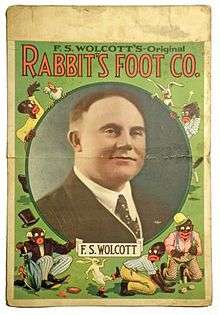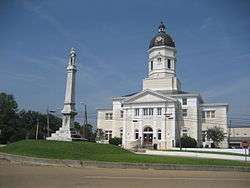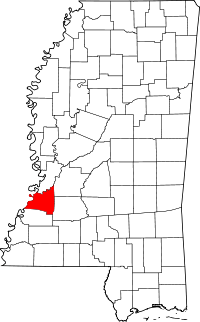Port Gibson, Mississippi
| Port Gibson, Mississippi | |
|---|---|
| City | |
|
Claiborne County Courthouse in Port Gibson | |
 Location of Port Gibson, Mississippi | |
 Port Gibson, Mississippi Location in the United States | |
| Coordinates: 31°57′22″N 90°58′59″W / 31.95611°N 90.98306°WCoordinates: 31°57′22″N 90°58′59″W / 31.95611°N 90.98306°W | |
| Country | United States |
| State | Mississippi |
| County | Claiborne |
| Area | |
| • Total | 1.8 sq mi (4.5 km2) |
| • Land | 1.8 sq mi (4.5 km2) |
| • Water | 0.0 sq mi (0.0 km2) |
| Elevation | 118 ft (36 m) |
| Population (2010) | |
| • Total | 1,567 |
| • Density | 870/sq mi (350/km2) |
| Time zone | Central (CST) (UTC-6) |
| • Summer (DST) | CDT (UTC-5) |
| ZIP code | 39150 |
| Area code(s) | 601 |
| FIPS code | 28-59560 |
| GNIS feature ID | 0676254 |
Port Gibson is a city in Claiborne County, Mississippi, United States. The population was 1,567 at the 2010 census.[1] Port Gibson is the county seat of Claiborne County[2] and home to the Claiborne County Courthouse.
The first European settlers in Port Gibson were French colonists in 1729; it was part of La Louisiane. It was chartered as a town in the U.S. in 1803 after the Louisiana Purchase. Due to development of cotton plantations in the area after Indian Removal, planters in the state imported thousands of African-American slaves from the Upper South. The county had a black majority established well before the Civil War; they were overwhelmingly enslaved.
Several notable people are native of Port Gibson. The town saw action during the American Civil War. Port Gibson has several historical sites listed on the National Register of Historic Places (National Register of Historic Places listings in Claiborne County, Mississippi).
In the 20th century, Port Gibson was home to The Rabbit's Foot Company, which had a substantial role in the development of blues in Mississippi, including taverns and juke joints now included on the Mississippi Blues Trail. With the decline in agriculture and lack of other jobs, the city and county have suffered from reduced population and poverty. The peak of population in the city was in 1950. A report in the New York Times in 2002 characterized Port Gibson as 80 percent black and poor, with 20 percent of families living on incomes less than $10,000 a year according to the 2000 Census. It also has an "entrenched population of whites, many of whom are related and have some historical connection to cotton."[3]
History
Chartered as a town on March 12, 1803, Port Gibson is Mississippi's third-oldest European-American settlement. It was developed beginning in 1729 by French colonists, and was then within French-claimed territory known as La Louisiane.
The now defunct Port Gibson Female College was founded here in 1843. One of its buildings now serves as the city hall.[4]
Port Gibson was the site of several clashes during the American Civil War and figured in Ulysses S. Grant's Vicksburg Campaign. The Battle of Port Gibson occurred on May 1, 1863, and resulted in the deaths of over 200 Union and Confederate soldiers. The battle was a turning point in the Confederates' ability to hold Mississippi and defend against an amphibious attack. Port Gibson is the site of the Port Gibson Oil Works, a cottonseed oil plant.
Many of the town's historic buildings survived the Civil War because Grant reportedly proclaimed the city to be "too beautiful to burn". These words appear on the town's city limits signs.[5] Historic buildings in the city include the Windsor Ruins, which have been shown in several motion pictures.
Although Port Gibson no longer has a Jewish community, Gemiluth Chessed synagogue, built in 1892, had an active congregation when the town was thriving as the county seat. It is the oldest synagogue and the only Moorish Revival building in the state.[6] The Jewish population gradually moved to areas offering more opportunity.
Mississippi Blues Trail
The Rabbit's Foot Company was established in 1900 by Pat Chappelle, an African-American theatre owner in Tampa, Florida. He owned the leading travelling vaudeville show in the southern states, with an all-black cast of singers, musicians, comedians and entertainers. After his death in 1911, the company was taken over by Fred Swift Wolcott, a white farmer, who based the touring company in Port Gibson after 1918, and continued to run it until 1950. The Rabbit's Foot Company remained popular, but was no longer considered "authentic."[7]
A historic marker on the Mississippi Blues Trail has been placed by the Mississippi Blues Commission in Port Gibson, commemorating the contribution that The Rabbit's Foot Company made to the development of the blues in Mississippi.[8]
Geography
According to the United States Census Bureau, the city has a total area of 1.8 square miles (4.7 km2), all land.
Demographics
| Historical population | |||
|---|---|---|---|
| Census | Pop. | %± | |
| 1890 | 1,524 | — | |
| 1900 | 2,113 | 38.6% | |
| 1910 | 2,252 | 6.6% | |
| 1920 | 1,691 | −24.9% | |
| 1930 | 1,861 | 10.1% | |
| 1940 | 2,748 | 47.7% | |
| 1950 | 2,920 | 6.3% | |
| 1960 | 2,861 | −2.0% | |
| 1970 | 2,589 | −9.5% | |
| 1980 | 2,371 | −8.4% | |
| 1990 | 1,810 | −23.7% | |
| 2000 | 1,840 | 1.7% | |
| 2010 | 1,567 | −14.8% | |
| Est. 2015 | 1,436 | [9] | −8.4% |
As of the census[11] of 2000, there were 1,840 people, 692 households, and 447 families residing in the city. The population density was 1,048.0 people per square mile (403.7/km²). There were 787 housing units at an average density of 448.2 per square mile (172.6/km²). The racial makeup of the city was 19.40% White, 80.00% African American, 0.05% Native American, 0.22% Asian, 0.05% from other races, and 0.27% from two or more races. Hispanic or Latino of any race were 0.71% of the population.
There were 692 households out of which 30.6% had children under the age of 18 living with them, 31.9% were married couples living together, 27.2% had a female householder with no husband present, and 35.3% were non-families. 30.8% of all households were made up of individuals and 13.9% had someone living alone who was 65 years of age or older. The average household size was 2.64 and the average family size was 3.33.
In the city the population was spread out with 29.3% under the age of 18, 10.5% from 18 to 24, 24.7% from 25 to 44, 20.9% from 45 to 64, and 14.5% who were 65 years of age or older. The median age was 34 years. For every 100 females there were 80.2 males. For every 100 females age 18 and over, there were 76.2 males.
The median income for a household in the city was $24,848, and the median income for a family was $28,958. Males had a median income of $28,036 versus $21,115 for females. The per capita income for the city was $12,928. About 26.0% of families and 31.3% of the population were below the poverty line, including 41.9% of those under age 18 and 26.3% of those age 65 or over.
Education
Port Gibson is served by the Claiborne County School District.
The Chamberlain-Hunt Academy, a Christian military boarding school, had been located in Port Gibson since 1879, but closed in 2014.[12]
Notable people
- Samuel Reading Bertron, banker
- Pete Brown, golfer, first African American to win on the PGA Tour
- Jay Disharoon, lawyer and Mississippi legislator
- Earl Van Dorn, Confederate Civil War general
- Constance Cary Harrison, author
- Irwin Russell, poet
- V. C. Shannon, member of the Louisiana House of Representatives from Shreveport from 1972 to 1974; born in Port Gibson in 1910
- Andrew Jackson Sevier, Louisiana sheriff
- F. S. Wolcott, American minstrel show proprietor
Gallery photos
 Lake Hamilton outside Port Gibson
Lake Hamilton outside Port Gibson

 Window card for F. S. Wolcott's Original Rabbit's Foot Co., based in Port Gibson
Window card for F. S. Wolcott's Original Rabbit's Foot Co., based in Port Gibson The marker placed by the Mississippi Blues Commission in Port Gibson to commemorate the Rabbit's Foot Company
The marker placed by the Mississippi Blues Commission in Port Gibson to commemorate the Rabbit's Foot Company
References
- ↑ "Profile of General Population and Housing Characteristics: 2010 Demographic Profile Data (DP-1): Port Gibson city, Mississippi". U.S. Census Bureau, American Factfinder. Retrieved March 28, 2012.
- ↑ "Find a County". National Association of Counties. Retrieved 2011-06-07.
- ↑ PETER T. KILBORN, "A Vestige of King Cotton Fades Out in Mississippi"], New York Times, October 18, 2002.
- ↑ Patti Carr Black; Marion Barnwell (2002). Touring Literary Mississippi. Univ. Press of Mississippi. p. 179. ISBN 978-1-57806-368-0. Retrieved August 19, 2012.
- ↑ Hendrickson, Paul (2003). Sons of Mississippi. New York: Alfred A. Knopf. ISBN 0-375-40461-9.
- ↑ Peter Applebome (September 29, 1991). "Small-Town South Clings to Jewish History". New York Times. Retrieved September 1, 2011.
- ↑ Lynn Abbott, Doug Seroff, Ragged But Right: Black Traveling Shows, Coon Songs, and the Dark Pathway to Blues and Jazz, Univ. Press of Mississippi, 2009, pp.248-268
- ↑ "Mississippi Blues Commission - Blues Trail". www.msbluestrail.org. Retrieved 2008-05-28.
- ↑ "Annual Estimates of the Resident Population for Incorporated Places: April 1, 2010 to July 1, 2015". Retrieved July 2, 2016.
- ↑ "Census of Population and Housing". Census.gov. Retrieved June 4, 2015.
- ↑ "American FactFinder". United States Census Bureau. Retrieved 2008-01-31.
- ↑ "Chamberlain-Hunt Academy to Close". WAPT Jackson. July 30, 2014.
External links
| Wikimedia Commons has media related to Port Gibson, Mississippi. |
-
 Port Gibson travel guide from Wikivoyage
Port Gibson travel guide from Wikivoyage - History of Port Gibson's Jewish community (from the Institute of Southern Jewish Life) (Archive)
- The Battle of Port Gibson
- Port Gibson on the Mississippi

